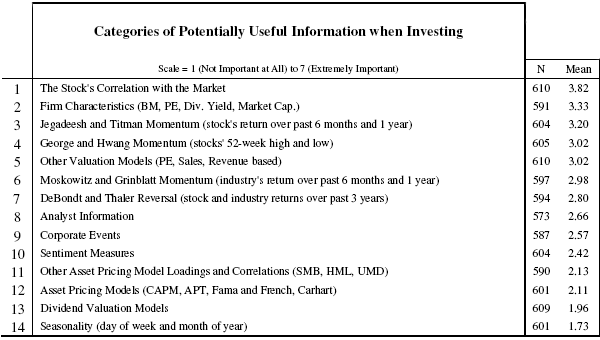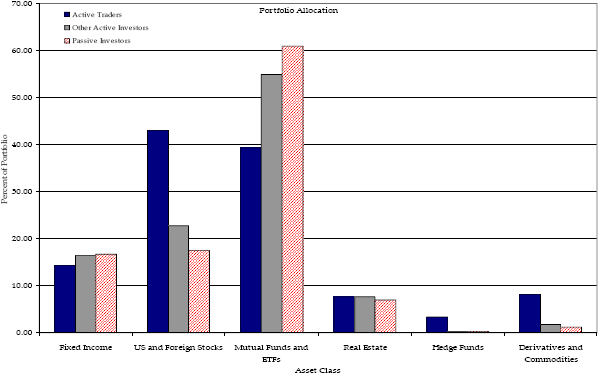How does “the group that is arguably best qualified, finance professors, …assess the importance of valuation techniques, asset-pricing models, market anomalies, firm characteristics, corporate events, seasonal variables, and other information” when they invest for themselves? In their April 2007 paper entitled “What Really Matters When Buying and Selling Stocks?”, James Doran and Colby Wright seek to answer this question via an email-initiated electronic survey of 4,525 finance professors at accredited U.S. universities and colleges. Using data provided by 642 qualified respondents, all with Ph.D.’s, they conclude that:
- Over two-thirds of finance professors are passive investors (not trying to beat the market).
- 14.5% of finance professors have never bought a stock; 57.4% have never bought an exchange-traded fund (ETF); 72.6% have never traded on margin; 78.6% have never sold a stock short; 65.4% (73.0%) have never bought a call (put) option; 79.9% (87.0%)have never written a call (put) option; 84.5% have never traded a futures contract.
- For the entire set of respondents, a stock’s correlation with the market (beta) tops the list of buy/sell decision factors, followed by widely used firm characteristics (price-earnings ratio, market capitalization and book-to-market ratio) and stock price momentum. Formal valuation and asset pricing models are at the bottom of the list, along with seasonality (day of the week and month of the year). It seems that finance professors use formal valuation methods and asset-pricing models in teaching and research, but not in investing. A predominantly passive investing approach perhaps explains why no buy/sell decision factor has great significance. (See the table below.)
- Among finance professors who are trying to beat the market, the three most important stock buying/selling decision factors are P/E, return for the past six months and beta. Five of the top ten decision factors for this subset relate to momentum.
- Among finance professors who trade stocks at least monthly and are trying to beat the market, P/E and market capitalization are the top two stock buying/selling decision factors. The next four factors all relate to momentum.
The following table, taken from the paper, ranks the mean ratings of all 642 responding finance professors for 14 stock buying/selling decision factors. On a scale of 1 (Not Important at All) to 7 (Extremely Important), none of the factors stand out as having great significance. Formal asset pricing/valuation models are near the bottom of the list. As noted above, a predominantly passive investing approach among respondents may explain the generally low mean ratings.

The following figure, also from the paper, summarizes investment asset allocations for three subsets of respondents. Active Traders buy stocks at least monthly and aim to outperform the market. Other Active Investors aim to outperform but trade less often. Passive Investors do not aim to outperform.

In summary, finance professors are mostly passive investors, but even those trying to beat the market clearly prefer popular investing indicators over formal (“academic”) valuation and asset pricing models.
Although not covered by the survey, it would be interesting to know the investing results of the respondent subgroups. Do finance professors who trade actively, or otherwise try to beat the market, do so?